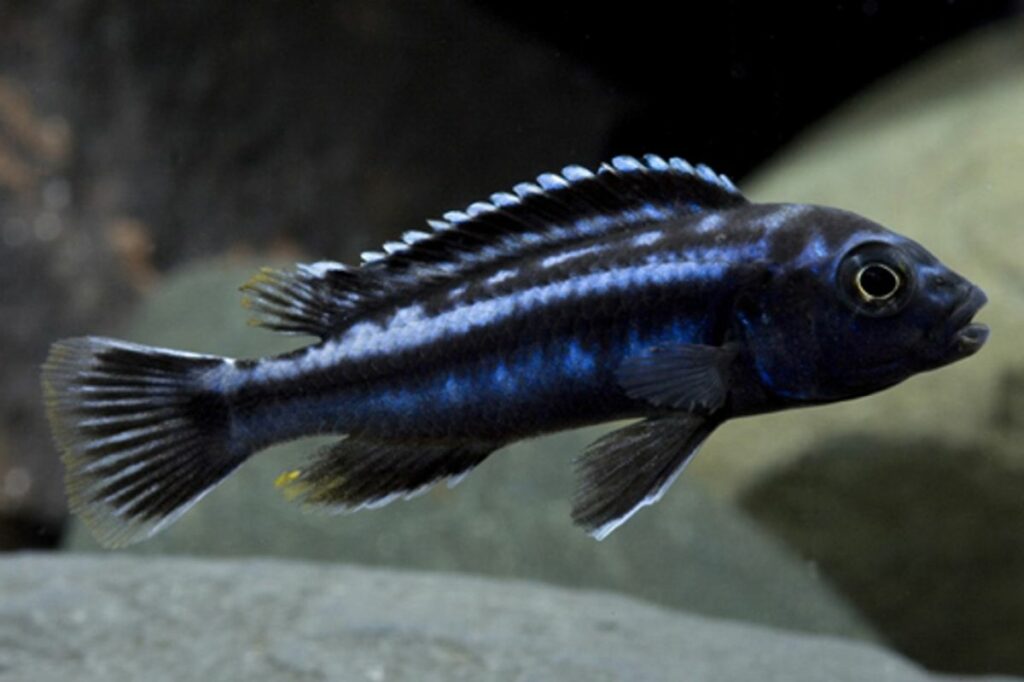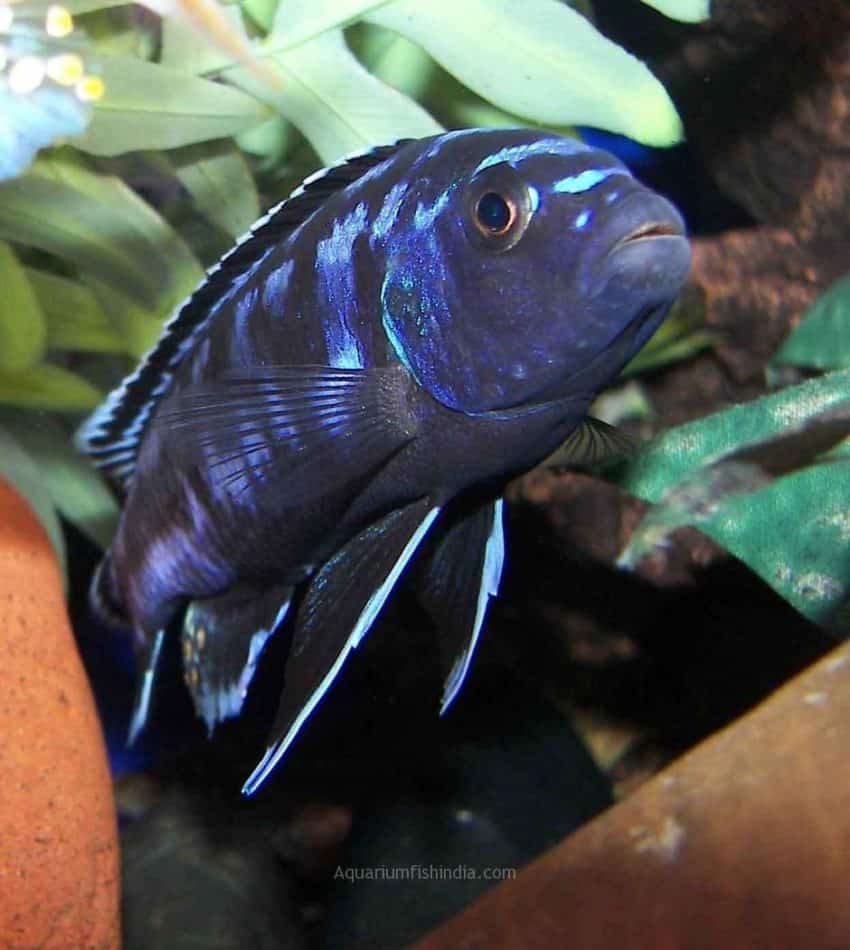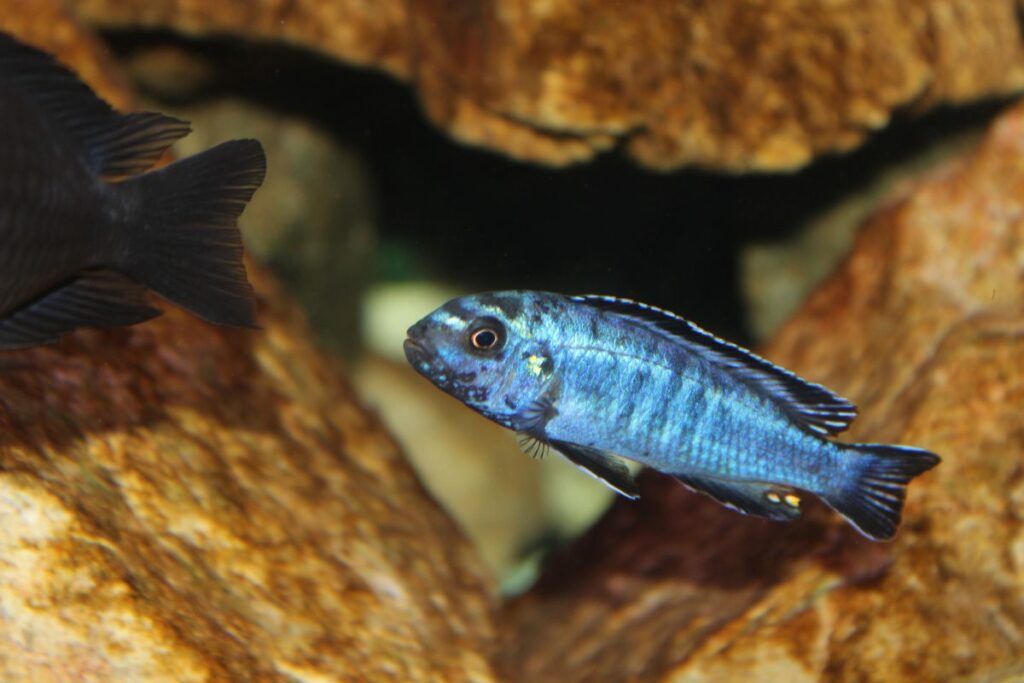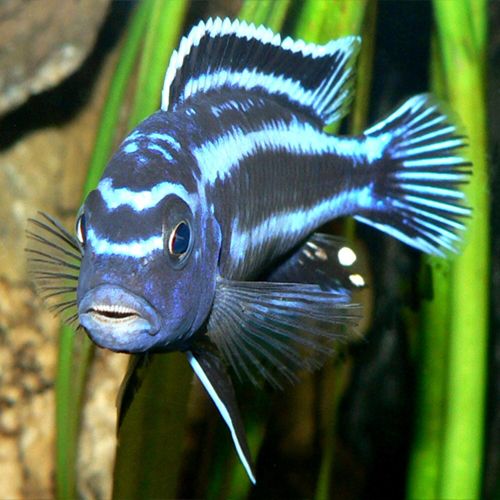Mbuna like the Electric Blue Johanni are Africa’s answer to the world of reef fish. African cichlids are brilliant in color, active, and able to live in large groups in close proximity. They come in a wide range of forms, from solitary predators to gregarious herbivores.
You can choose from dwarf cichlids, true giants, and everything in between. But the Electric Blue Johanni is an aquarium staple for several good reasons.
What is the Electric Blue Johanni?
The Electric Blue Johanni cichlid is one of the top 10 African cichlids out there in terms of popularity. Also known as Melanochromis johanni, this fish is a type of ‘Mbuna.’
Mbuna is a local word for rock dwelling cichlids that live along the shallows of Lake Malawi. These fish graze on algae with small helpings of aquatic invertebrates they find.
Most are aggressive fish yet they’ve also evolved to live together in close proximity. Packed community tanks of these cichlids are popular for this reason. Any fights are short lived and subdominant fish never get picked on too often.
Mbuna like the Johanni Electric Blue are also easy to breed and long lived. You should get up to 10 years of life from an Electric Blue Johanni.
- Common Names: Electric Blue Johanni, Melanochromis johanni ‘Electric Blue’
- Scientific Name: Melanochromis johanni
- Origin: Lake Malawi
- Length: 3 to 4 inches
- Aquarium Size: 30+ gallons
- Temperament: Aggressive
- Ease of Care: Easy
Electric Blue Johanni vs Maingano
African cichlids are well known for their beauty that matches that of marine coral reef fish. But several species are not just stunning – they also vary depending on where they are caught.
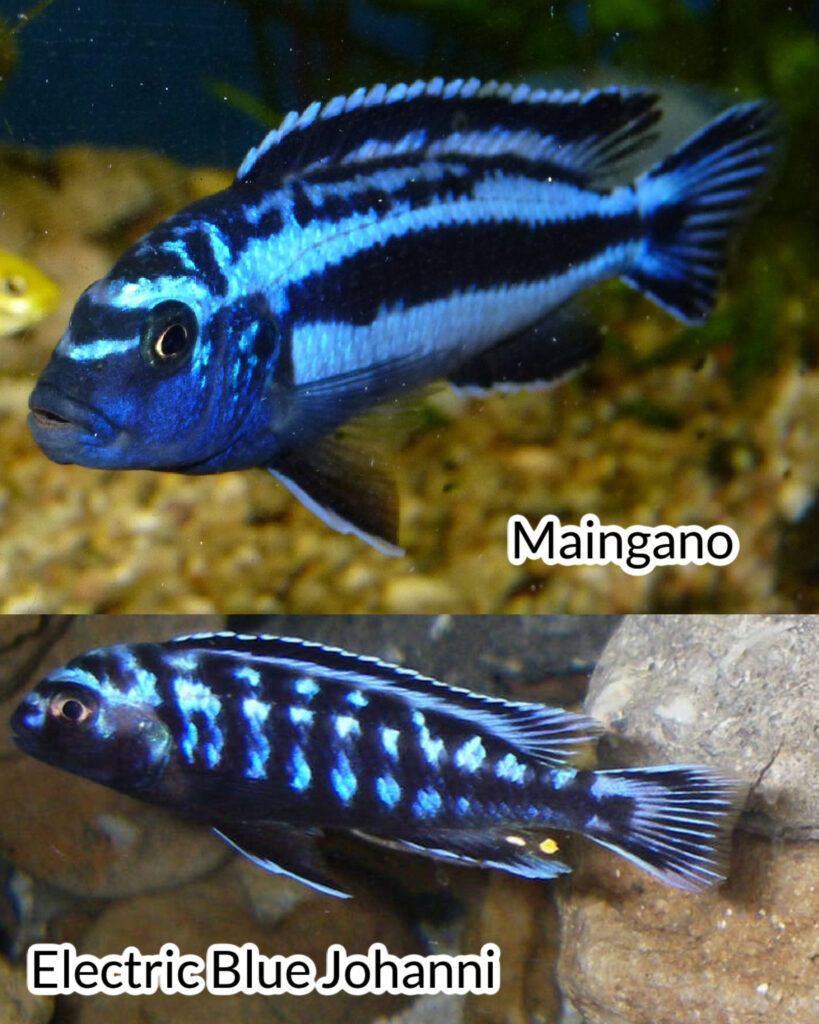
Different regions of Lake Malawi can have populations of fish that are the same species. And these isolated groups may be a little or very different in color or size compared to fish from other parts of the lake.
The Maingano is just such an example. At a brief glance both it and the Electric Blue Johanni look identical. But the Maingano cichlid has better defined blue and black stripes. Such a bold color ensures they are in constant demand with aquarium hobbyists.
Maingano cichlids will command a higher price compared to the common Electric Blue Johanni. But both cichlids are identical in terms of care, feeding and breeding.
Electric Blue Johanni Cichlid Care
Caring for the Electric Blue Johanni is not a complicated affair. So long as you provide them with hard water, appropriate tank mates, and a vegetarian diet you’re guaranteed to succeed. They will also breed, allowing you to appreciate the devoted care cichlids show their fry.
Melanochromis Johanni Electric Blue Tank Size
The first step to owning a successful colony of African cichlids is choosing the right size aquarium. You could keep an Electric Blue Johanni adult trio in an aquarium as small as 20 gallons. As long as they were the only fish and you didn’t want any tank mates.
Since you may want to keep other fish, a larger tank is important. 30 gallons is a good minimum – with 40 to 55 gallons being better if you want a mixed mbuna community tank.
All Mbuna are aggressive so extra space gives you room for an occasional fight. Plus you can keep more competitors to distract the winners from harassing the losers too much.
Plants and Substrate
While Electric Blue Johanni lean towards vegetarianism, they don’t eat aquarium plants. Softer plants like Elodea and Cabomba might get picked at if they don’t have algae or an appropriate plant-based diet.
That said, most aquarium plants will not do well in the conditions these cichlids prefer. Most plants prefer neutral to somewhat soft and acidic conditions. Versus the very hard and alkaline water found in Lake Malawi.
The substrate can be sand or gravel; either choice is fine. But do pay attention to the needs of their tank mates. If you keep Peacock Cichlids with your Melanochromis Johanni Electric Blue then you should use sand.
Water Conditions for the Electric Blue Johanni
One of the few ways you might not succeed at Electric Blue Johanni Cichlid care is by providing improper water conditions. These cichlids need hard, alkaline water (pH 8.0-8.5) as these are the conditions of Lake Malawi.
Almost all of the Johanni you will find in pet stores are captive bred. So they may be acclimated to a lower pH (7.3-7.6 is common for tap water in most countries). But you will see better color, growth, and breeding activity with a higher pH.
Lucky for you, raising the pH and hardness is easier than lowering it. Raising the pH and hardness involves adding substances while lowering means removing dissolved substances. Plus you have to prevent them from coming back.
Buffering and Water Chemistry
Decorations for an African cichlid tank should keep these qualities in mind. Driftwood, for example, contains tannins and humic acids that lower the pH. Rocks like seiryu stone, marble, and limestone, will push the pH higher.
Driftwood is still safe to use so long as you have rocks and a substrate that counteracts the acids contained within. Most African cichlid keepers also use crushed coral as a substrate. As in a marine aquarium crushed aragonite keeps the water buffered towards acidity.
Buffering capacity, by the way, is how much resistance the water has to changes in chemistry. PH swings can be fatal. So in general, the more buffering capacity you have the better (unless you have soft water species like Bee Shrimp).
Water Temperature for Lake Malawi Cichlids
The water temperature should fall in a range of 73-78°F; nice and moderate. A few degrees above this range is doable. Raising the temperature is very helpful if your cichlid Electric Blue Johanni catches ich. Otherwise, keep the temperature to this range.
Electric Blue Johanni Diet
Like most mbuna the Electric Blue Johanni African cichlid is omnivorous but leans towards a vegetarian diet. They eat algae that grows on the rocks found in the shallow water regions along the lake’s shoreline.
But they also snap up aquatic insects, small worms, shrimp, and other invertebrates that live in the algae and plants.
The best African Cichlid food formulas use spirulina and chlorella as a base. These are aquatic algae and a natural source of food for mbuna. A few times per week supplement this diet with brine shrimp, blood worms, and other fresh and frozen items.
Both cichlid pellets and flakes are fine for feeding your Electric Blue Johanni. You can even offer blanched vegetables sometimes. Lettuce, zucchini, squash, and spinach will be eaten with relish.
Electric Blue Johanni Cichlid Tank Mates
Any Electric Blue Johanni Cichlid tank mates should either be fast or also aggressive. As mbuna go, the Johanni is average in terms of temperament. Other mbuna are your best options. The Zebra Mbuna (Maylandia zebra), Yellow Lab (Labidiochromis caeruleus), and the related Yellow Auratus (Melanochromis auratus) are good options.
If you want fish other than cichlids then choose fast moving species that live in open water. Hard water loving fish include Swordtails, Rainbowfish, and Giant Danios.
Bottom dwellers should be chosen with care and semi-aggressive to aggressive. Synodontis nyassae is a catfish native to Lake Malawi you will find in pet stores catering to African cichlid lovers.
Electric Blue Johanni Breeding
So long as you provide your Electric Blue Johanni ample food and the right water conditions breeding will happen. These fish are mouth brooders; the female collects the eggs in her mouth as soon as they are laid and fertilized.
The Electric Blue Johanni cichlid female then carries them in her mouth for 3 to 4 weeks until they hatch. During this period she does not eat at all. So you need to feed your Johanni well before then so she has ample fat reserves.
The fry are free swimming at birth but will dart back into her mouth if threatened. When born the Electric Blue Johanni baby fish are big enough to eat live brine shrimp nauplii and other food.
As they grow up the fry will switch to eating algae and other food like their parents. Once the fry are large enough you can then offer your captive bred Electric Blue Johanni for sale.
Conclusion
Electric Blue Johanni cichlids are easy to find in most local pet stores. The males and females are both beautiful in color. And while they are aggressive they are no meaner than other rock dwelling mbuna cichlids. This makes adding the Johanni to a mixed cichlid community tank easy to do.
More Frequently Asked Questions About the Electric Blue Johanni
The Electric Blue Johanni is a great African cichlid to try if it’s your first time keeping them. But maybe you have a few more questions on their care and breeding.
You can tell the difference between an Electric Blue Johanni male vs female with a quick look. These fish are sexually dimorphic, meaning you can tell the male from female just by looking. Males are the fish with the electric blue color. Female Johanni will be yellow to orange in color.
Yes; the Electric Blue Johanni is an mbuna. This is a local word for the rock dwelling cichlids that live along the shoreline of Lake Malawi, eating algae off the rocks. Mbuna in general are aggressive but also compatible living in large groups.
The Electric Blue Johanni is one of the most common African cichlids for sale. Your local pet store will have a few in stock, including chain stores like Petsmart and Petco.
